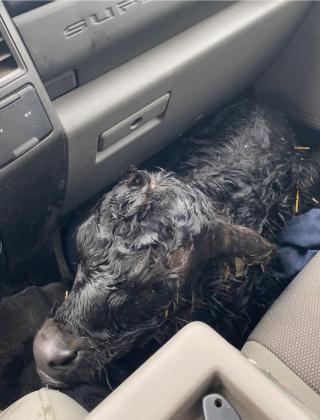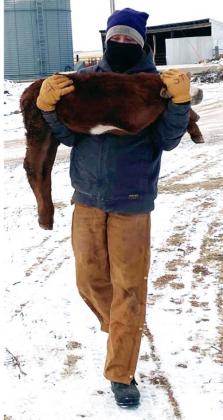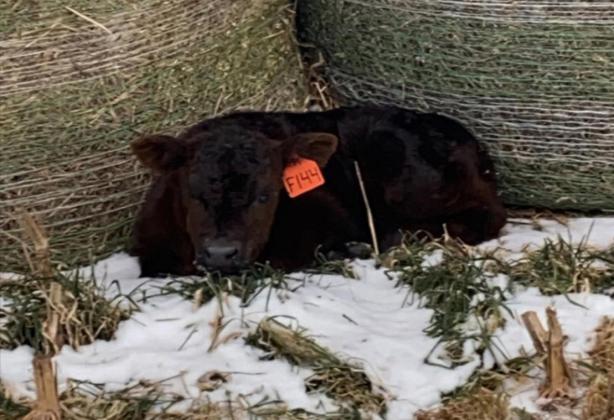Many cattle producers in Washington County have been working day and night the past two weeks to keep livestock bedded and fed and newborn calves alive. It’s calving season at quite a few farms around the area, and the record-cold temperatures have made a busy time of year exceptionally exhausting.
Brent Hynek, who farms north of Barnes, and Shawn Taddiken, of Clifton, are just two of the many cattle producers in the area who have been battling the extreme cold during calving.
“We are checking [cows] every one-anda-half-to-two hours trying to get them in the barn before they calve,” Hynek said, adding that he has been putting newborn calves in calf warmers to dry off or using a hair dryer and towels if the warmers are full. Once the calves are dry, he gets them to nurse off their mothers right away.
He said if room is needed in the barn, the new calves and their mothers are turned outside at about 12 hours old where they have straw bedding and a windbreak.
Taddiken said on Monday evening that he has had only 13 calves born since the cold snap began — though a few more calves were born late Monday night — and six of those calves came on Friday, Feb. 12. He said he is checking for calves every hour or two, and he shares the calf-checking duties with his father, Mark Taddiken, and hired man Stephen Kieffer, though he said he takes the evening and overnight checks.
Taddiken said that each evening he pens heifers in the barn that he thinks are about to calve . The cows are the real challenge in this weather, he said, simply because there are so many more of them, and it’s much more difficult to do daily sorting.
“As soon as we have a cow calve, we grab her calf and use it as bait to lure the mom from the big calving lot into the barn,” he said. “Calves born in extreme cold are often sluggish. You expect heifers and heifer pairs to be a project, but in this arctic cold, the cows become real work too.”
He said he sometimes sits in his pickup to “babysit” a cow that he thinks is preparing to calve.
“In these temps, nearly every calf that is born will be put in a pickup, calf box, or even our basement,” he said. “In these conditions, a newborn calf that is wet can die very quickly even if their mom is claiming them and doing a good job of cleaning them off. The calves that have extreme hypothermia get bathed off in warm water to get their body temperature up as rapidly as possible. We have a small stock tank in the basement that we fill with warm water to get calves going. After the calf is washed up, we dry it off with old towels, and a blow dryer or show-blower. They get tubed with colostrum once we get them halfway warm.”
He said that the overnight checking schedule has left him “kinda tired,” but the most exhausting part is carrying the calves around.
“The strangest part about this cold snap is the duration,” he said. “It’s not unusual to have a few bitter cold days in Northern Kansas, especially after a snow, but to have 10-plus days consecutive of bitter cold isn’t something we are used to, nor is it something most people have facilities to adequately handle. We’ve made some makeshift pens in sheds and improvised to accommodate a larger number of penned up [cowcalf] pairs than what is normal.
Bottle calves are expected to be highly sought after right now as producers try to find a replacement calf for good cows if they lost one in the cold. Multiple people have reported privately selling a calf from a set of twins for $300 or more. Bill Keesecker, who manages Marysville Livestock, said on Monday that he is getting requests for bottle calves. He said bottle calves will bring $250 to $400 depending on the condition of the calf.
Caring for livestock
Both Hynek and Taddiken said daily or near-daily bedding of the cattle has been an essential task the past two weeks, especially with the persistent snows that have fallen throughout the cold snap. Milo stalk bales, corn stalk bales and wheat straw bales have all been used as bedding in recent weeks.
Another essential task in weather like this is to keep the cattle well-fed, they said.
“Just keep feed in front of them all the time,” Hynek said.
Taddiken said his bred heifers are getting freechoice brome hay and corn silage while the bred cows are getting free-choice wheat straw, corn silage and alfalfa.
Both men said that in addition to the extra bedding and feeding, they have been spending more time thawing waterers and chopping ice the past two weeks.
“Waterers and pump houses have been an ongoing challenge,” Taddiken said. “We’ve had two pump houses freeze up after older space heaters couldn’t keep up, but we’ve replaced them and are going again. We have to haul warm water to refill frozen waterer when the pump houses do go out.”
Vets busy
Veterinarian Phil Bentz from Animal Health Center said his practice has been seeing a lot of calves with frostbite and hypothermia. He said it will be 10-to-14 days before the full extent of the damage is seen in these calves.
He said he is also seeing a lot of prolapses, which is more common in cold weather. He said those prolapses need to be tended to quickly to prevent frostbite. Uterine prolapses that get frostbitten will produce scar tissue and may lead to open cows next year.
Veterinarian Garrett Stewart of Washington Vet Clinic said there will be quite a few newborn calves now with frozen ears, tails and feet, which will lead to decreased prices at auction later this year. He said to prevent that frostbite, producers have to be to the newborn calves “remarkably quick” after calving. He said producers can tape calves’ ears back to their necks to help prevent frostbitten ears.
Bentz said it is also important for producers who are calving in this weather to make sure the calves are getting enough colostrum because they may not want to get up and nurse in frigid temperatures.
He said bred cows’ nutrition during this cold snap as well as their body condition scores will play a large role in the energy level of newborn calves born several weeks from now.
Stewart said the maintenance needs of livestock have increased 4o-percent during the frigid weather, and producers should have been adding energy to their feed rations. He said bedding the cattle will reduce their maintenance needs some.
Both veterinarians said the extreme cold has put lots of stress on the livestock, which will make them more susceptible to pneumonia, scours and other issues in the coming weeks.
Any drastic temperature change can lead to pneumonia and respiratory issues, Bentz said. Next week’s forecast calls for temperatures in the 5os, and Bentz said the 75-degree temperature swing in only a matter of days will no doubt cause issues for livestock.




